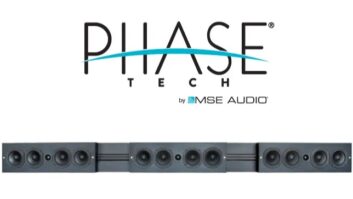Object-based surround sound and flat-panel TVs have emerged as key themes for audio suppliers here at the CEDIA Expo, where multiple companies are launching their first audio/video receivers and audio/video processors with object-based surround decoding.
These products also include the companies’ first audio electronics with HDMI 2.0a connections and HDCP 2.2 copy protection to pass through protected Ultra HD content supporting all of the latest visual enhancements.
More companies are also unveiling amplifiers designed for placement behind a flat-panel TV to enhance TV sound, and new thin speakers are also appearing to take their place next to thin TVs.
Companies showing their first audio/video receivers or audio/video processors equipped with Dolby Atmos and DTS:X include Athem, AudioControl, DataSat, JBL Synthesis and Sony. In addition, MartinLogan is showing its first Atmos speaker modules.
At the show, Denon, Marantz, Trinnov, Sony and Acurus from Indy Audio Labs will demo DTS:X.
For flat-panel TVs, Artison is building many of the major features of an A/V receiver into a thin device that can be mounted behind a flat TV mounted on a table, in the wall, or on the wall. And PhaseTech is showing an amplifier/surround decoder that connects to a TV’s audio output to reproduce two to three front channels when connected to passive speakers, particularly the company’s new thin speakers.
And one company, Peerless A/V, is unveiling the industry’s first outdoor powered soundbar for outdoor TVs.
The introductions will leverage growing demand for Ultra HD TVs, OLED TVs, and the proliferation of larger and larger TV-screen sizes, all bringing people back to installers and encouraging people to trade up their home theater’s audio system to match the performance of their new TVs, marketers said.
So far, the emergence of the Dolby Atmos and DTS:X object-based surround formats on Blu-ray discs and in audio components hasn’t produced a major lift in AVR sales because the technologies are still new, marketers have said. But they will eventually encourage home theater upgrades, particularly upgrades to add in-ceiling speakers that deliver height channels.
Here’s what suppliers are showing in home theater and two-channel audio.
Astell&Kern: High-resolution portable-audio company Astell&Kern is expanding its home audio presence with the October shipment of the $3,799- MAP AKT1 all-in-one high-resolution audio system.
The AKT1 is a slim T-shaped 39-inch-tall sound system that stands on the floor and incorporates stereo speakers. It’s positioned as a space-saving way to play back high-res audio at home.
The company’s first home audio product, launched earlier this year, is the $12,000 high-res 500N Network Music Player with 1TB SSD drive. It connects to existing home audio systems.
Amplifier Technologies: The company is bringing its BGW Immersive Sound amplifiers from movie theaters to home theaters at a suggested $8,890 each.
For more modest home theaters, the company launched a new amplifier series, the 4000 series, available in two- to seven-channel models. They share the same design philosophy as the step-up 6000 series but with power output reduced to 200 watts per channel RMS into 8 ohms and 300 watts into 4 ohms.
The two-channel model costs $2,995; three channels go for $3,595, four channels for $4,195, five channels for $4,795, six channels for $5,395, and seven channels for $5,995.
They are available in standard 17-inch and rack-mount 19-inch chassis.
Anthem: Dolby Atmos and DTS:X will appear for the first time in an Anthem A/V processor and two of three new Anthem AVRs. DTS: X will be available later as an update, likely via firmware. All ship in January.
The Atmos-equipped AVRs and AVP will also be the company’s and likely the industry’s first such products with DTS Play-Fi wireless multiroom-audio technology, which streams music via Wi-Fi from computers, smartphones, network storage devices, and the cloud.
All of the products are also the company’s first components with HDR-supporting HDMI 2.0a and with HDCP 2.2 copy protection, which passes through copy-protected Ultra HD streams from 4K Blu-ray players and 4K set-top video streamers. Pricing was unavailable.
The AVP is the AVM 60 with 11.1-channel output, including four height channels. It also comes with Anthem Room Correction (ARC).
The AVRs are the five-channel MRX 520, seven-channel MRX 720, and 11-channel MRX 1120, which is the brand’s first 11-channel AVR. They ship late this year at an unannounced price.
The 520 lacks Atmos and DTS:X, but the 720 features seven-channel amp and supports 11-channel Atmos and DTS:X speaker configurations via an add-on amp. The 1120 supports 11-channel speaker configurations via its 11-channel amp, but it also offers 11-channel preouts to add a higher power amp.
All three AVRs also feature 192kHz/24-bit high-resolution audio playback and 18Gbps HDMI.
The top two AVRs and the AVP also feature wireless DTS Play-Fi multiroom-audio technology.
Artison: The company built many of the major components of an A/V receiver into a thin device that can be mounted behind a flat TV mounted on a table, in the wall, or on the wall.
The $999-suggested Nano Backpack incorporates a 3×100-watt amp to power front speakers in a home theater and wireless WiSA technology to stream the surround and subwoofer channels to WiSA-compliant surround speakers and subs.
The device, which measures 1 by 9 by 9 inches, also incorporates HDMI 2.0 inputs and output for connecting a Blu-ray player or settop IP video streamer; Dolby Digital, DTS and Dolby Pro Logic II and IIx surround decoding; Bluetooth for music streaming; and IR- and IP-based control, the latter for control from computers.
It features three HDMI inputs, one Toslink optical input, a 3.5mm stereo minijack, and RJ45 connector. Its HDMI output features audio return channel and Ultra HD passthrough.
It ships in the second quarter.
AudioControl: In its biggest product launch ever, AudioControl is unveiling nine products, including its first two AVRs equipped with Dolby Atmos, HDCP 2.2, HDMI 2.0a, and DTS:X upgradability. None of these capabilities had been offered before by an AudioControl AVR.
The company is also launching new line of compact multizone amplifiers, all packing more power in a smaller chassis than previous models, and multizone amplifiers/matrix switchers.
The AVRs, shipping in the fourth quarter, are the Concert AVR-7 and Concert AVR-9, both of which power a 7.1.4 speaker system with the addition of a four-channel amp. The AVR-7 features 7×100-watt output into 8 ohms and is 4-ohm-stable. The AVR-9 produces 7×120 watts into 8 ohms and boosts output to 7×200 watts into 4 ohms.
Both AVRs come with seven HDMI 2.0a inputs, four coax and two Toslink digital audio inputs, six analog-stereo inputs, USB input, plus Ethernet and RS-232 connectivity to integrate with home-automation systems. Both offer second-zone HDMI outputs with ARC. They are also the company’s first AVRs to feature Dirac room correction.
Datasat: The newest version of the company’s RS20i A/V processor will be the company’s first A/V processor to offer Dolby Atmos and DTS:X as well as HDMI 2.0 and HDCP 2.2 copy protection. DTS:X will be available as a firmware upgrade early next year.
Like before, it features Auro-3D surround processing. It also features HDMI 2.0 with HDCP 2.2 copy protection.
The $23,170 component supports Auro3D up to 13.1 channels and Atmos/DTS:X up to 7.1.4 and 9.1.2 channels. Its predecessor cost $19,000. It’s based on the architecture of the Datasat AP20 cinema processor, used in premium movie theaters worldwide.
Other features include 16 channels, Dirac Live room EQ, 20 memory presets for all settings, third-octave parametric and shelving EQs, low and high band-pass filters on all channels.
It will be available with Atmos around show time.
Current RS20i owners will get the option to upgrade to Dolby Atmos for a suggested $3,170 . Atmos will be a field-serviceable hardware upgrade that will accept the company’s DTS:X firmware upgrade. Current RS20i owners will get the option to upgrade to HDMI 2.0 / HDCP 2.2 for $1,117. It will be a factory upgrade.
Denon: The D+M brand continues to expand its selection of AVRs with Atmos and capability for an upgrade to DTS:X and Auro 3D. The latest such AVR is the $2,199 AVR-X6200W, expected in October to replace a $1,999 model and become the come in right under the current $2,999 flagship Compared to its predecessor, the new 9×140-watt model adds DTS:X upgrade capability, HDMI 2.0a, and HDCP 2.2. The latter two are available on all eight HDMI ins and three outs.
Thanks to its 11.2-channel processing capability, the AVR-X6200W can support up to 7.1.4 or 9.1.2 Atmos speaker configurations when a two-channel amp is added. Auro 3D is supported up to 10.1 channels with an add-on amp.
MartinLogan: The brand’s first Dolby Atmos speaker modules, which can be used to bounce height-channel information off a ceiling, are priced at $599/pair. They were expected to ship in November.
The two-way coaxial modules fit most flat-top L-R speakers but are said to look best when paired with MartinLogan’s Motion series speakers.
Each Motion AFX features a 0.75-inch aluminum dome tweeter and 5.25-inch polypropylene cone bass/ midrange driver with stamped-steel basket, all incorporated into a high-gloss black cabinet. The cabinet is designed to angle the drivers toward the ceiling in order to deliver sound effects above listeners.
Sony: The company is launching its first and only AVR with Dolby Atmos, DTS:X and HDMI 2.0a. The $2,799 ES-series ZA5000E is due sometime in the first half. It wasn’t certain whether it would ship with DTS:X or if the decoder would be available later as a firmware upgrade.
The AVR features eight-port Ethernet hub to simplify the installation of connected networked devices. A ping button fires “discovery” protocols for different-brand CI controllers to connect to them.
Transformative Engineering: The $199-suggested HAI-1 Audio Injector lets users inject audio into a TV’s HDMI signal path. In one application, it would eliminate the need for a separate center-channel speaker by using a TV’s speakers as the center channel.













